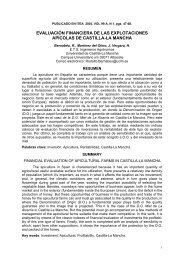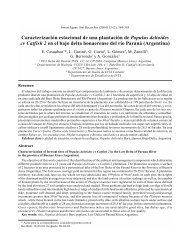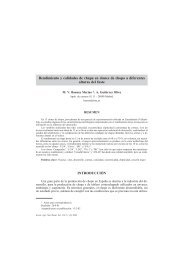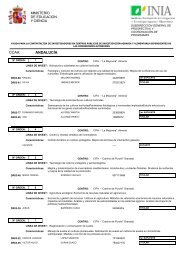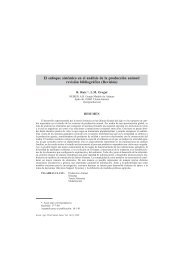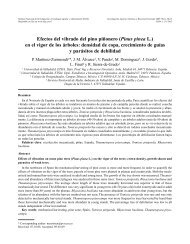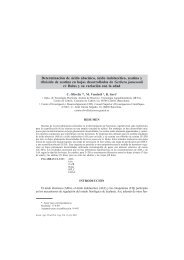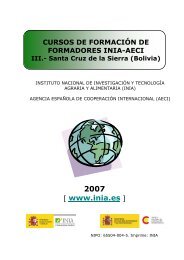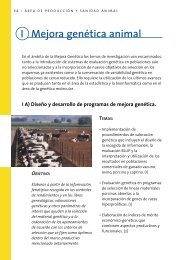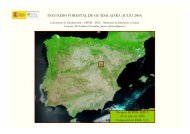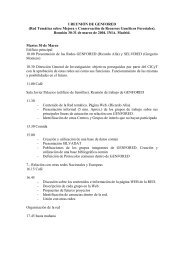Status of medicinal and aromatic plants in - Inia
Status of medicinal and aromatic plants in - Inia
Status of medicinal and aromatic plants in - Inia
Create successful ePaper yourself
Turn your PDF publications into a flip-book with our unique Google optimized e-Paper software.
44<br />
WORKING GROUP ON MEDICINAL AND AROMATIC PLANTS: FIRST MEETING<br />
Medic<strong>in</strong>al <strong>and</strong> <strong>aromatic</strong> <strong>plants</strong> <strong>in</strong> Estonia<br />
Ulve Pihlik<br />
Tartu University, Pharmacy Institute, Tartu, Estonia<br />
Introduction<br />
The flora <strong>and</strong> vegetation <strong>of</strong> Estonia are both very <strong>in</strong>terest<strong>in</strong>g for their biological diversity.<br />
Despite its small surface area, Estonia has two different biogeographical subdivisions.<br />
Geologically, eastern Estonia can be characterized by its s<strong>and</strong>stone bedrock <strong>and</strong> western<br />
Estonia by its limestone bedrock. Therefore different soil types occur <strong>in</strong> these areas. The<br />
composition <strong>of</strong> plant communities <strong>of</strong> western Estonia is, <strong>in</strong> turn, under the <strong>in</strong>fluence <strong>of</strong> the<br />
more maritime climate. These conditions give rise to very different plant communities.<br />
About half <strong>of</strong> Estonia is covered by forest, over 20% by mires, <strong>and</strong> about 20% by meadows.<br />
The <strong>in</strong>digenous flora <strong>of</strong> Estonia <strong>in</strong>cludes approximately 1500 vascular <strong>plants</strong>. More than 500<br />
plant species are situated on the marg<strong>in</strong> <strong>of</strong> their distribution area: 121 on the northern, 128 on<br />
the northeastern, 45 on the eastern, 56 on the southeastern, 27 on the southern, 11 on the<br />
southwestern, 15 on the western <strong>and</strong> 52 on the northwestern marg<strong>in</strong>s.<br />
Legislation<br />
The Law <strong>of</strong> Natural Objects under Protection (passed <strong>in</strong> 1994, supplemented <strong>in</strong> 1998) establishes<br />
the terms for the protection <strong>of</strong> both plant communities <strong>and</strong> plant species. Almost 10% <strong>of</strong> the<br />
country’s area is subject to various levels <strong>of</strong> protection. The strict regime <strong>of</strong> protection<br />
applies to over 1% <strong>of</strong> the whole area, <strong>and</strong> is planned to cover up to 5% <strong>of</strong> the ma<strong>in</strong>l<strong>and</strong> by<br />
2010. The above-mentioned law has established the follow<strong>in</strong>g categories <strong>of</strong> protection:<br />
• Conservation areas<br />
- national parks, meant for the protection <strong>of</strong> typical l<strong>and</strong>scapes <strong>and</strong> the biological<br />
diversity <strong>of</strong> ecosystems (Lahemaa – northern Estonian plant communities; Karula –<br />
southern Estonian plant communities; Soomaa – the communities <strong>of</strong> mires <strong>and</strong> bogs;<br />
Vils<strong>and</strong>i – littoral communities);<br />
- wildlife conservation areas, meant for the protection <strong>of</strong> rare species <strong>and</strong> species <strong>in</strong><br />
danger <strong>of</strong> ext<strong>in</strong>ction;<br />
- l<strong>and</strong>scape conservation areas (parks, arboreta, botanical gardens), usually small;<br />
- programmed areas, <strong>in</strong> which monitor<strong>in</strong>g, research work <strong>and</strong> educational activities are<br />
carried out <strong>in</strong> accordance with the programme;<br />
• Protected natural <strong>in</strong>dividual objects (live or lifeless natural objects <strong>of</strong> high scientific,<br />
historical or cultural value (e.g. s<strong>in</strong>gle trees, rocks <strong>and</strong> stones, waterfalls, caves, etc.);<br />
• Species, fossils <strong>and</strong> m<strong>in</strong>erals under protection.<br />
Endangered plant species are divided <strong>in</strong>to three categories accord<strong>in</strong>g to the protection<br />
regime:<br />
1. The first category <strong>in</strong>cludes 22 protected species <strong>of</strong> high scientific value (relicts, species<br />
with a narrow area <strong>of</strong> distribution <strong>and</strong> those on the marg<strong>in</strong> <strong>of</strong> an area), very rare <strong>plants</strong><br />
(1-5 sites) <strong>and</strong> clearly endangered species (Kukk 1999).<br />
2. The second category (145 species) consists <strong>of</strong> rare <strong>and</strong> endangered species <strong>and</strong> species <strong>of</strong><br />
scientific value, for which the threat is not as acute as for the species <strong>in</strong> the first category.<br />
They <strong>in</strong>clude endemic species, relicts from earlier climatic periods or species situated on<br />
the marg<strong>in</strong> <strong>of</strong> their distribution area. The follow<strong>in</strong>g species used as <strong>medic<strong>in</strong>al</strong> <strong>plants</strong><br />
belong to this category: Taxus baccata L., Jovibarba globifera (L.) J. Parnell (syn. J. sobolifera<br />
(Sims) Opiz), Prunus sp<strong>in</strong>osa L., Rubus arcticus L., Hedera helix L., Helichrysum arenarium (L.)<br />
Moench <strong>and</strong> Orchis spp.




